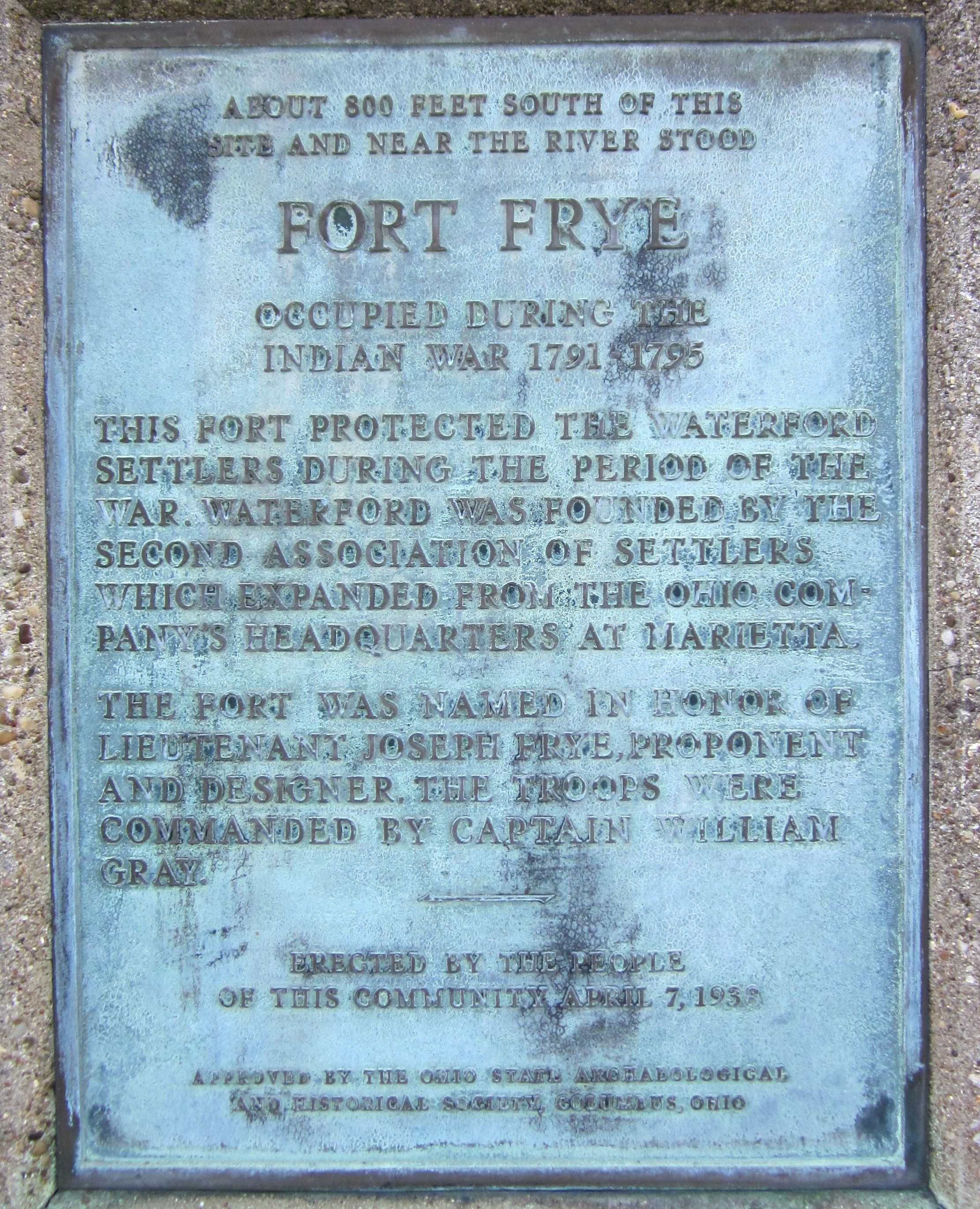Fort Frye on:
[Wikipedia]
[Google]
[Amazon]
 Fort Frye was a triangular defensive fortification built by a group of pioneers from the
Fort Frye was a triangular defensive fortification built by a group of pioneers from the
 Fort Frye was a triangular defensive fortification built by a group of pioneers from the
Fort Frye was a triangular defensive fortification built by a group of pioneers from the Ohio Company of Associates
The Ohio Company of Associates, also known as the Ohio Company, was a land company whose members are today credited with becoming the first non- Native American group to permanently settle west of the Allegheny mountains. In 1788 they establis ...
who moved about twenty miles up the Muskingum River
The Muskingum River (Shawnee: ') is a tributary of the Ohio River, approximately long, in southeastern Ohio in the United States. An important commercial route in the 19th century, it flows generally southward through the eastern hill country o ...
from the settlement of Marietta, Ohio
Marietta is a city in, and the county seat of, Washington County, Ohio, United States. It is located in southeastern Ohio at the confluence of the Muskingum and Ohio Rivers, northeast of Parkersburg, West Virginia. As of the 2020 census, Mar ...
to a location near the mouth of Wolf Creek. During 1789 the pioneers established settlements now known as Waterford
"Waterford remains the untaken city"
, mapsize = 220px
, pushpin_map = Ireland#Europe
, pushpin_map_caption = Location within Ireland##Location within Europe
, pushpin_relief = 1
, coordinates ...
and Beverly on the southwest and northeast banks of the Muskingum, respectively. The settlements were located about 13 miles downriver from a small group of pioneers at Big Bottom. During January and February 1791, following the massacre at Big Bottom and the start of the Northwest Indian War
The Northwest Indian War (1786–1795), also known by other names, was an armed conflict for control of the Northwest Territory fought between the United States and a united group of Native American nations known today as the Northwestern ...
, the settlers built Fort Frye at Beverly.
The form of the fort was triangular, which is rather uncommon in military defenses. But as they were in a hurry, and it saved them one line of curtains, while the block houses at the angles defended the sides just as well as in any other form, it was adopted. The base of the triangle rested on the river, distant only a few paces from the bank, and was about two hundred feet in length. One of the other sides was somewhat longer, so that the work was not a regular triangle. At each corner, was a two story block house, twenty feet square below, and a foot or two more above. The two longer sides were filled in with dwelling houses, some of which were two stories high, and others of a lesser height, while a considerable portion were built barrack fashion, with only one roof, pitched inward, so that the rain from it fell within the garrison. The spaces not occupied by buildings were filled in with stout pickets. Broad, substantial gates, near the northern block house, led out through the palisades into the highway and fields, while a smaller one in the curtain on the bank, called the water gate, afforded an opening to the river. A line of palisades, twelve feet high, at the distance of thirty feet, inclosed the whole, and descended to the river.Hildreth, ''Pioneer History'', 440-41.
Regional forts
Down the Muskingum River at Marietta, at the confluence of the Muskingum and Ohio rivers, United States troops builtFort Harmar
Fort Harmar was an early United States frontier military fort, built in pentagonal shape during 1785 at the confluence of the Ohio River, Ohio and Muskingum River, Muskingum rivers, on the west side of the mouth of the Muskingum River. It was buil ...
, and the Ohio Company of Associates built Campus Martius
The Campus Martius (Latin for the "Field of Mars", Italian ''Campo Marzio'') was a publicly owned area of ancient Rome about in extent. In the Middle Ages, it was the most populous area of Rome. The IV rione of Rome, Campo Marzio, which covers ...
and Picketed Point Stockade. Down the Ohio River from Marietta, associates built Farmer's Castle
Farmer's Castle was a defensive fortification built opposite the mouth of the Little Kanawha River on the Ohio River by a group of pioneers from the Ohio Company of Associates. It was located about 15 miles downriver of Marietta, Ohio, the first ...
at the location of modern-day Belpre, Ohio.
See also
*American pioneers to the Northwest Territory
This is a list of early settlers of Marietta, Ohio, the first permanent settlement created by United States citizens after the establishment of the Northwest Territory in 1787. The settlers included soldiers of the American Revolutionary War an ...
*Ohio Company of Associates
The Ohio Company of Associates, also known as the Ohio Company, was a land company whose members are today credited with becoming the first non- Native American group to permanently settle west of the Allegheny mountains. In 1788 they establis ...
References
{{Reflist, 2Bibliography
* Hildreth, S. P.: ''Pioneer History: Being an Account of the First Examinations of the Ohio Valley, and the Early Settlement of the Northwest Territory'', H. W. Derby and Co., Cincinnati, Ohio (1848). Northwest Indian War Forts in Ohio Pre-statehood history of Ohio Buildings and structures in Marietta, Ohio 1791 establishments in the United States Military installations established in 1791